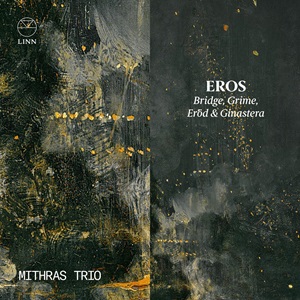
Eros
Frank Bridge (1879-1941)
Phantasie Trio (Trio No 1 in C minor) (1907)
Helen Grime (b. 1981)
Three Whistler Miniatures (2011)
Iván Eröd (1936-2019)
Piano Trio No 1, Op 21 (1978)
Alberto Ginastera (1916-1983)
Danza de la mosa donosa from piano suite Danzas Argentinas (1937 arr. Popplewell 2022)
Mithras Trio
rec. 2022, Milton Court, London
Linn CKD733 [57]
I live not far from Paxton House, a splendid Georgian mansion in the Scottish borders, close to Berwick-upon-Tweed. For nearly twenty years, the house’s glorious picture gallery has been home to Music at Paxton, a ten-day festival of chamber music. The acoustics are marvellous, perfectly suited to small ensembles. One of the features of the festival is support for young artists. It was at the recent festival that I heard the Mithras Trio, who were exceptional in a programme of Tailleferre, Saint-Saëns and Beethoven; his Archduke Trio has never sounded better.
Established in 2017 while students at the Guildhall School of Music and Drama, the group has won a number of international prizes. Named as BBC Radio 3 New Generation Artists for the 2021–2023 seasons, they have recorded extensively for BBC Radio 3. Record labels have been slow to catch up with them, and, shockingly, this is their debut album. The programme of works by Bridge, Grime, Eröd and Ginastera shows the breadth of their musical interests and the maturity of their musicianship.
I think Frank Bridge’s music is for adults, as when I was younger I found his works hard to get into, but now I am in my twilight years, my ears are open to his beautifully crafted works. His Phantasie Trio won the Cobbett Prize in 1907, and it is easy to see why. It is a wonderfully constructed single movement work full of memorable tunes and perfectly written for the ensemble. Frank Bridge was of course a viola player of some standing, being a member of the English String Quartet for many years. Mr Cobbett was himself very taken with the work and in a lecture given at the Royal Academy of Music in 1911 told the assembled crowd: “Mr Bridge’s Trio is of a remarkable beauty and brilliance and stamps him as one of our foremost composers for the chamber.” Indeed it is.
The ostensibly single span of the work clearly embraces a number of sections, with the piece being shaped like an arch. The problem is to make the work flow smoothly with a sense of architecture. Here, that is seamlessly achieved. There are many impassioned crescendos that could overpower the structure, but the group’s unified musical thinking makes them all seem natural and inevitable. There is much variety of emotion and texture packed into this short work. When the opening material reappears near the end, it is feels like the welcome return of an old friend. The piano writing is particularly difficult throughout and there are some uncomfortable quick scales in thirds and sixths which Mr. Degavino makes light of. This is undoubtedly my favourite recording of this work. The final pages of radiant C major have never seemed more joyous.
Helen Grimes’ Three Whistler Miniatures was inspired by three chalk and pastel miniatures, which are displayed in the Isabella Stewart Gardner Museum in Boston. The music does not try to conjure up the pictures; rather, the composer has tried to create the intimate atmosphere suggested to her by each of them. They are unusually imagined with the violin and cello acting as a sort of unit which is set against the piano. The piano writing is often in the upper register of the keyboard and has the effect of unsettling the normal balance of the piano trio sound world. The opening movement The Little Note in Yellow and Gold is the most entrancing, reminding me at times of Takemitsu’s delicately unsettling works.
Iván Eröd is a name new to me and one whose acquaintance I am happy to make. Apparently, some of his earlier music was serial, but his Piano Trio No 1, is a lively, ingratiatingly accessible work that clearly shows his Austro-Hungarian background. There is the conciseness of Haydn with Bartókian Hungarian folk influence, all mixed with some French Impressionist harmonies and hints of jazz. The slow movement is an exquisite barcarolle in which the pianist’s technique in chordal arpeggios is put to the test, while the violin and cello get heart-achingly singing melodies. The finale is set very much in Hungary, with exuberant dance rhythms throughout.
The disc ends passionately with an arrangement of Alberto Ginastera’s Danza de la moza donosa (Dance of the Graceful Girl) from his 1937 piano suite Danzas Argentinas. The arrangement was made by the group’s cellist Leo Popplewell in 2022 and works very well. There is more than a hint of Piazzola, who was a student of Ginastera, in this engaging miniature.
The Mithras Trio have a musicality and sense of ensemble that belie their youth and clearly have great things ahead of them with. At the risk of hyperbole, their sound world reminds me of a young Beaux Arts Trio. Well done to Linn for commissioning their first CD.
Paul R W Jackson
Buying this recording via a link below generates revenue for MWI and helps us keep free access to the site



Mithras Trio:
Ionel Manciu (violin), Leo Popplewell (cello), Dominic Degavino (piano)

















